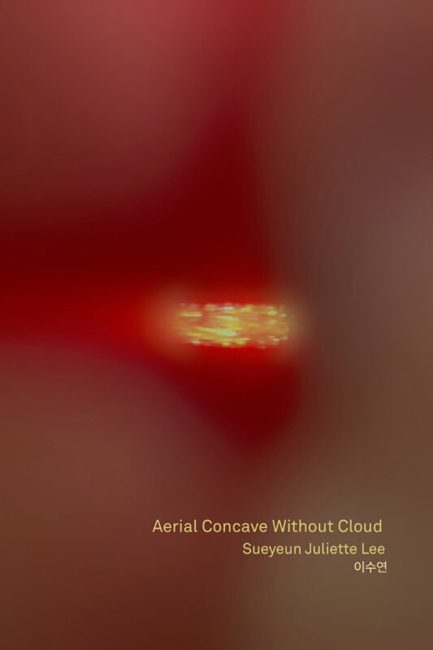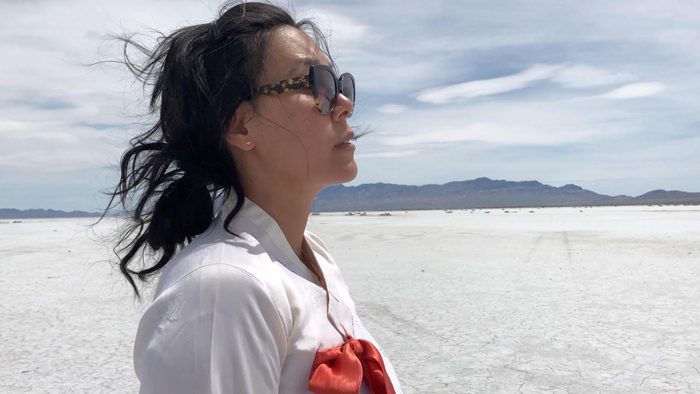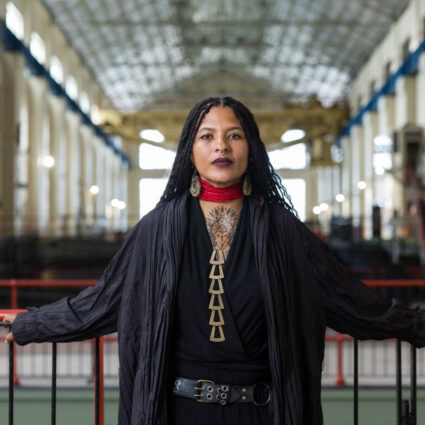Sueyeun Juliette Lee’s Aerial Concave Without Cloud is an extended meditation on how thinking through and with light can help to illuminate profound personal grief.

Aerial Concave Without Cloud by Sueyeun Juliette Lee
Nightboat Books, 2022, paperback, 113 pages.
Advance praise: Orion Magazine’s “28 Recommended Collections for National Poetry Month.” “Sueyeun Juliette Lee is one of those writers whose poetry enters my body in a profound and uncanny way.” – Janice Lee.
For fans of: Dictee by Theresa Hak Kyung Cha and The Poetics of Space by Gaston Bachelard.
All artists who succeed in creating a large enough body of work can, I think, be said to have one or a few “great subjects” to which they continually return. And to the extent that this is true, there’s likely no avoiding it; the wellspring of art is the unconscious, and we do not choose the contents of our unconscious. Our primal obsessions are given to us, not chosen.
Aerial Concave Without Cloud is the fifth collection by the Denver-based poet and multimedia artist Sueyeun Juliette Lee. To those already familiar with her work, the title of this collection will signal a continuation of themes that animate her other collections, the two most recent of which are titled Solar Maximum (Futurepoem Books, 2015) and No Comet, That Serpent in the Sky Means Noise (Kore Press, 2017). It would not be terribly controversial, I think, to say that one of Lee’s great subjects is light.
Aerial Concave is not shy in acknowledging this. The book begins with the following epigraph from the philosopher Gaston Bachelard: “To enclose light is to prepare the way for life.” In a straightforward way, of course, life owes its existence to light; the vast majority of life on earth is animated by energy derived from the sun. In the book’s first poem, a serial work entitled “the appropriate information in the negative,” Lee makes it clear that she is thinking in these terms:
consider the entire process in
a unified manner from the start
a complex and fluid medium
light enters ultimately
at the intuitive level
merging into a single coherent function
more commonly recognized as life

In the epigraph, Bachelard posits a connection between light and life not unlike that between parent and child. Scrutinizing this connection further, however, leads us to a chicken and egg problem: between “light” and “life,” which is the parent, and which is the child? If “to enclose light is to prepare the way for life,” what should we think of as the enclosing vessel?
For Lee, one such vessel is the human body. “[P]art of the ensuing discourse about light /,” the book begins, “was written at my desire / to comprehend the phenomena / through the lens of my / breathing body.” But the speaker’s body is not the only one in play. A number of poems make reference to magma, and specifically “The Black Magma Inside You.” This image, vivid on its own, also creates a visceral connection between the “bodies” named in the titles of many of the poems—the “grief body,” the “mother body”—and the body of the earth itself, whose blood, if you will, is magma. “The Black Magma Inside You” thus comes to serve as a figure for a profound and deeply embodied grief.
As much as Aerial Concave is a book about light, it is also, and perhaps more fundamentally, a book about grief—a grief that is never quite named and that, perhaps because of this, comes to feel almost cosmic in scale, or at least planetary. Much as Boethius found consolation in philosophy, Lee seems to find consolation in geology, ecology, and cosmology. But this consolation comes not from minimizing her personal grief so much as from coming to see it as of a piece with larger geological processes. The “grief body” is the speaker’s, but it is also the body of the earth itself. The undulations of grief thereby take on something of the stark sublimity of tectonic shifts, or the slow migrations of glaciers as they carve and reshape the earth’s surface.
Lee’s interest in these movements—of glaciers, the earth, the stars—connects quite naturally with her interest in dance. Several poems take the form of choreographic instructions, and a series of poems with the same title (“A Slow Turn and Sash”) function as meditations on a particular style of Korean shamanic dance. As Lee explains in the second poem titled “A Slow Turn and Sash,” 살풀이, pronounced “salpuri” and meaning, roughly, “releasing death,” is a dance performed by Korean shamans, called “mudang,” to cast out death, misfortune, or evil spirits.
The latter section of the book includes several photographs of Lee wearing the white hanbok traditionally donned by mudang and wielding the white sash used when dancing the salpuri. In one particularly striking image, Lee stands on what appears to be a precipice overlooking an inlet or a bay, arms extended upward, throwing the white sash over her head so that it almost becomes one with the bright clouds overhead. The sash becomes the clouds, and Lee as mudang become one with the landscape in which she dances.
In a later poem entitled “A Slow Turn and Sash,” a Sami resident of Norway—the Sami, not coincidentally, have their own shamanic tradition—informs Lee that “the northern lights could be controlled and made more energetic by standing beneath them with a white sheet.” The dancer’s white sash thus becomes an extension of the glowing pleats of the northern lights; light speaks to light. Lee’s grief may not have been exorcised, but we might say that it’s been sublimated, made sublime. And grief, no longer merely personal, becomes something cosmic, elemental—a force of nature, like the magma that moves beneath the earth’s crust, or the roaring arctic winds.



